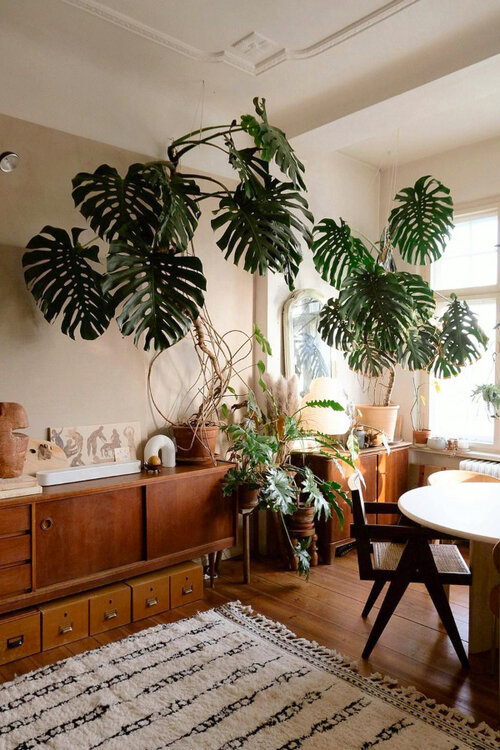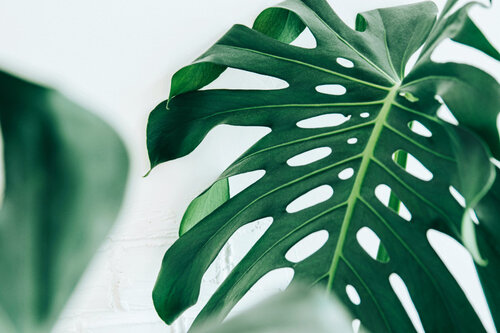The instruction manual for caring for Monstera deliciosa is right here! I take care of light, soil, water, and fertilizer—all the horticultural essentials. The video demonstrates how to repotted Monstera. So let's get to the meat of the matter: Monstera.
Due to its striking leaves, Monstera deliciosa is a botanical and design icon. This tropical plant's photogenic foliage, which features enormous leaves, odd and exquisite holes, and a deep green, tropical appearance, has made it a star online.
Although monsteras may have the appearance of exotic hot house plants, cultivating and caring for them is actually pretty simple. They grow to astonishing sizes with little effort and are excellent plants for novices.
They are spreading over social media in both houseplant communities and as a popular green accent piece for interior design.
Do you wish to learn how to grow one of these lovely plants for yourself? I'll demonstrate. So let's investigate this exotic and wonderful plant together.
This post is divided into three sections for your reading convenience:
Characteristics of Monstera (how to differentiate it from a Split Leaf Philodendron)
How to properly care for your Monstera: soil, water, light, and fertiliser
Design ideas for incorporating Monstera into your home's interiors
An introduction to Monstera deliciosa - a tropical Aroid
The popular indoor plant family Aroids, which also includes Philodendrons, Anthuriums, Caladiums, and many other tropical plant species, includes Monstera deliciosa. It is indigenous to the tropical woods of southern Mexico and Central America.
In a tropical setting, the monstera broadleaf vine can reach heights of up to 70 feet. In addition to its numerous tentacle-like aerial roots and big, deeply lobed leaves, it has a stout stem.
The word "Monstera" is Latin for "abnormal," referring to the plant's unusually attractive perforated leaves, and "deliciosa," meaning "delicious," referring to the fruit, which is said to taste like a combination of banana, guava, and pineapple.
Swiss Cheese plant is a frequent name, but I've only ever heard writers use it. I think this is because Monstera deliciosa has a far more interesting name and is one of the few easily recollectible Latin plant names.
Monstera deliciosa vs. Split Leaf Philodendron
The Split Leaf Philodendron, also known as Thaumatophyllum bipinnatifidum (formerly known as Philodendron bipinnatifidum; botanists love to reclassify species), and Monstera are both members of the Araceae family that are sometimes confused with one another.
However, you generally won't mix them up again after you become familiar with the variations in their foliage. The most straightforward method to tell them apart is that Monstera contains what are known as leaf fenestrations, which are holes inside the leaves.
This is distinct from Split Leaf Philodendron, which lacks fenestrations like Monstera but has extremely deeply lobed leaves.
Another distinction is that Split Leaf Philodendron foliage is quite triangular in comparison to Monstera leaves, which are heart-shaped. Comparing the two plants below can help you understand this. (Click for a larger view.)
Monstera foliage - juvenile vs. mature
One additional vital detail about Monstera foliage is that it has both young and mature leaves. The juvenile Monstera leaf is much smaller than the mature foliage and is heart-shaped without any lobes or fenestrations.
The mature foliage has the recognisable, beloved heart-shaped leaf that we all know and love; it may grow up to two feet in the wild and has deep lobes and fenestrations.
It is thought that Monstera evolved in this way to allow wind and light to reach the lower foliage, reducing the likelihood of leaf tearing.
How to care for your Monstera deliciosa - light, soil, water, repotting, fertilizer
Any nutrient-rich, well-draining indoor potting mix is suitable for Soil Monstera. Perlite added into a peat-based medium works nicely. Increase the pot's size to encourage greater growth and bigger leaves.
Water
I always wait until the soil in my plants, especially Monstera, begins to dry out before I water them. Underwatering is much less harmful than overwatering. Depending on the situation, watering once a week will usually suffice. That stated, as long as it is within reason, Monstera will accept excessive or insufficient irrigation.
Tropical plants like monstera benefit from humidity and will love misting or humidifiers because of this. If the humidity is too low, the leaf edges may become brown. During the winter, keep your Monstera away from heating vents as these may dry them out.
Since I don't have a humidifier, I occasionally like to spray down my plants when I water them. I submerge them in water in the shower or the washbasin. It thoroughly waters the plant and cleans and moisturises the foliage.
Light Monstera are considered understory plants since they grow beneath the canopy of a rain forest. This indicates that they prefer filtered, rather than direct, sunlight.
I discovered this the hard way when I scorched the leaf on my Monstera last autumn and winter because the sun was shining directly through the window and at an oblique angle. When exposed to excessive sunlight, monstera foliage turns yellow, and that is exactly what happened to me.
For the autumn and winter, I had to move it away from the window. Now that summer has arrived, the sun is overhead, protecting the plant from burning.
Fertilizer
When you regularly apply high nitrogen fertiliser, foliage plants like Monstera will reward you with bigger, better leaves.
The most popular plant fertilisers typically contain a combination of potassium (K), phosphorus (P), and nitrogen (N). This is written as "N-P-K" next to three numbers that represent the weight ratios of each constituent on the product label.
Nitrogen is primarily responsible for the plant's total shoot growth, or "vegetative growth," which is growth that is not blooming or reproductive in nature.
The development of roots, flowering, and seed germination are all regulated by phosphorus.
Potassium is necessary for the regulation and operation of plant cells.
Instead of flowers, we cultivate Monsteras for their leaves. (However, they are also planted elsewhere for their delicious fruit.) This is why we need a fertiliser with a higher nitrogen to phosphorus and potassium ratio. N:P:K ratios should ideally be 3:1:2 or 3:1:3.
So search for similar ratios when purchasing a fertiliser intended for your Monstera (or leafy plants in general). Different ratios won't harm it, but for gorgeous foliage, a high nitrogen fertiliser is best.
During the spring and summer growing seasons, fertilise.
growth pattern
Remember that Monstera is a vine; as such, a support pole will be beneficial to it, and a trellis will reward you with greater foliage.
My Monstera will be moved into a much larger pot with this support pole after I purchased the 36" coir-fiber vine pole shown below (middle image). Then, I can relax and let it grow!
The pole on the right is convenient because it is a set of four 12" poles that can be stacked to reach a height of 48" if you choose.
Monstera potting & display tips
In the end, monsteras can get fairly big and occupy a lot of area. A stunning, tropical specimen can be created by placing it in a statement planter with a tall pole. If you don't have enough space for a homegrown jungle or don't want one, it can also be kept in a much smaller pot and clipped.
If your Monstera gets out of control, trim a few of the leaves and put them in your favourite vase. In addition to being a beautiful display of sparse greenery, the leaves can persist for months, making for inexpensive décor.
On the wall, did you see the adorable pink and green leafy watercolour? It gave me the motivation to explore Monster décor instead of just Monstera! I've chosen some accessories and artwork for your consideration below.
I don't typically talk about clothes here, but I couldn't help myself. I adore each of these three things. Where were you then, gorgeous tropical foliage? I looked so hard for a case like the one below when I acquired my 12 Pro a few months ago. The swimsuit is definitely something I'd wear, and the earrings are on their way to my house.
These are my suggestions for cultivating and decorating your home with Monstera deliciosa to make a stunning, tropical statement. It's grown to be one of my favourite plants, and I can't wait to see how large it becomes as the leaves develop.
Please let me know if you have any other inquiries about Monstera by leaving a comment below.








![How To Waterproof Your Plant Pots [5 Minute DIY]](https://blogger.googleusercontent.com/img/a/AVvXsEgH9Y9bMy5i1jeEXDVjrNritwSFcwnlvkV9bcBcsYZp8aLZUTesr0H1RAhYd3J3Em9ZVUIPmg8oyXFZ_Kjj0rwj6sG7n56kS75WWIX5vD32U6eIRgciFa02CnsovgXyidPktHlhcjMa7rJb0wZlvZpiovKsjPxGr60IZSHgbIKQKZdQivzJbcffRsjtMw=s72-c)


No comments:
Post a Comment